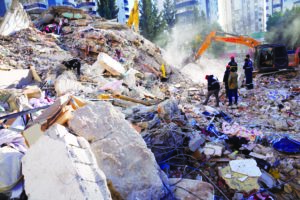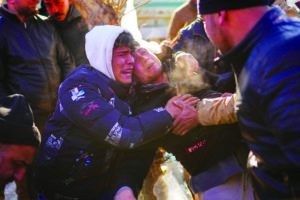The death toll of the massive earthquakes that have rocked the Turkey-Syria border region has now exceeded 5,000 people and the World Health Organization has suggested it could rise as high as 20,000. The catastrophe has led to an international outpouring of support. Numerous international rescue, medical, and other teams are arriving and on their way.
As ever, local emergency services were first on the front line to pull survivors from the collapsed buildings. We know from researching previous earthquake responses that most survivors are pulled out of the rubble by local residents and workers in the immediate aftermath.
 But rescue attempts are ongoing and reports are continuing to emerge of people being found alive under the rubble, despite freezing temperatures at night and poor weather in many earthquake-affected areas.
But rescue attempts are ongoing and reports are continuing to emerge of people being found alive under the rubble, despite freezing temperatures at night and poor weather in many earthquake-affected areas.
Having researched disasters in conflict zones for more than 20 years, I’m acutely aware of how difficult the task will be in Turkey and Syria. This border region is riven with conflict which not only impedes the response to the disaster, but also often prevents or inhibits work to reduce the risk of earthquake impacts.
Yet effective diplomacy and a willingness for countries to work together despite their tensions can make a huge difference.
The area over which shocks continue to be felt has suffered long-term violent conflict. Kurds in the region have been fighting for a homeland for years in Turkey, Syria and Iraq.
Syria has been shattered by civil war since 2011, so the area around Turkey’s border with Syria is packed with refugees from the fighting and is a crossing point for terrorists.
Reports are emerging that Damascus is demanding control of aid crossing into Syria and is allowing relief supplies to enter the region through only one border crossing. There have been calls for more crossing points to be opened to allow aid to get to disaster-affected people in Turkish areas affected by the quakes but so far there is no confirmation that Syria will allow this.
 However, past experience tells us that if countries who are seemingly at loggerheads can pull together after a catastrophe such as this, it can sometimes yield dividends.
However, past experience tells us that if countries who are seemingly at loggerheads can pull together after a catastrophe such as this, it can sometimes yield dividends.
Turkey itself provides an instructive example. For several decades, Turkey has had a fraught relationship with its neighbour Greece, including over Cyprus since Turkish forces invaded the north in 1974 in response to a coup supported by the Greek military government of the time.
And yet two earthquakes in 1999 challenged this picture of mutual enmity and distrust.
On August 17, more than 17,000 people died in an earthquake in north-west Turkey.
Greece offered extensive assistance and Turkey accepted.
Then on September 7, Turkey’s main search-and-rescue team phoned the Greek ambassador to Turkey to explain that they had heard that Athens had been rocked by a tremor and to offer assistance. The quake killed over 140 people. A Turkish team pulled at least one trapped person from the rubble.
Since then, collaboration between Greece and Turkey on preventing disasters – involving wildfires, earthquakes and other hazards – has endured despite the shifting status of their diplomatic relationship
Now, less than two months after threats of war over disputed territory in the Aegean Sea, Greece is once again offering disaster aid to help Turkey in the wake of the latest earthquakes.
Stopping earthquake disasters
However, measures to help prevent disasters are always more useful than international post-disaster aid, which is notoriously inefficient. It usually takes at least 24 hours for an international search-and-rescue team to be on site and active.
It’s expensive, too. As part of our research, we calculated that the approximate cost per post-earthquake life saved by international search-and-rescue teams is US$1 million (£830,000).
Research has shown that “informal disaster diplomacy” aimed at preventing or mitigating disaster impacts, such as those seen in these earthquakes, tends to be more successful than cooperation after the event.
Long-term pre-earthquake actions are certainly far more effective for saving lives and helping people than waiting until the ground has shaken and infrastructure has collapsed.
From the US to Japan, many lives have been saved by building codes and planning regulations – not to mention a population that knows what to do before and during an earthquake. It’s eminently possible these days to build structures that can withstand seismic shaking.
Because of our ability to mitigate the effects of hazards such as earthquakes, researchers avoid the phrase “natural disaster”.
Earthquakes will always happen as the earth’s tectonic plates can and do shift. But it doesn’t follow that this must always mean a disaster. And we can make ourselves less vulnerable to tremors by working together – even with our political enemies.(The Conversation)



